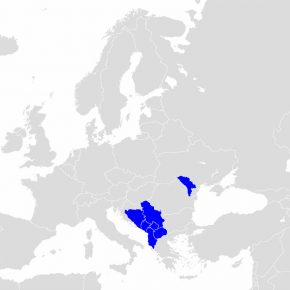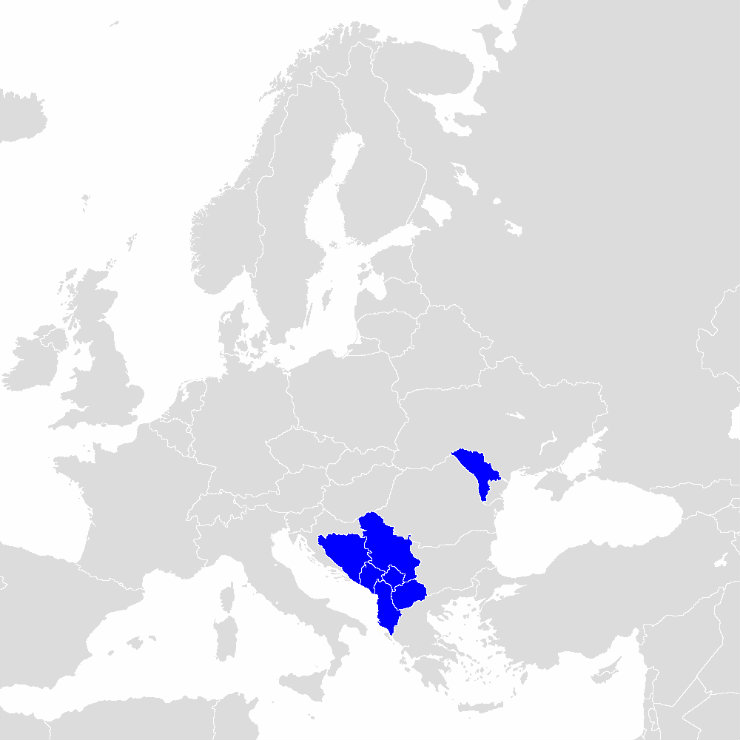
CEFTA countries (Marko7, CC BY-SA)
Serbia has also surplus of EUR2.1bn in trade with this area. According to Rasim Ljajic Minister of Trade, his country exports more to the CEFTA countries than to Russia, China and America together, and, as Serbian daily Politika reports, the reason of it is that the „economy in this case is a step ahead before politics.”
“All signatory countries increased their exports to the EU by 75 per cent and the EU is the main trade partner of all them. 10 years ago Serbia exported goods worth EUR1.8bn to countries of CEFTA, but a decade later EUR2.8bn. Before the agreement Serbia had a trade surplus of EUR1.1bn with these countries while today it is EUR2.1bn,” said Ljajić.
The Minister of Trade indicated also how to raise the agreement to a higher level: “We should harmonize the Protocol 5 on trade facilitation, reduce waiting lines at the borders, do more work on the harmonization of customs and the recognition of documents.” Ljajić added that in order to facilitate the mobility of workers in the areas of health, construction, services, the works are ongoing on liberalization of trade and services, but also on the recognition of professional qualifications.
Head of the EU Delegation to Serbia Michael Davenport explained that the agenda of regional economic integration is in accordance with the integration agenda in the context of the Berlin process. This initiative aims at revitalization of the integration of the Western Balkans with the EU by strengthening ties between the Balkan states and Western European core participating in the initiative – France, Italy, Austria, and first of all – Germany. On the other hand it stimulates and encourages cooperation between the Balkan states itself. Extra- and intra-regional cooperation should on the one hand provide another stabilizing factor in politically shaky part of Europe, and on the other an anchor holding the Balkan ark on the EU waters.
This is indeed the case. According to the data provided by the Observatory of Economic Complexity, the top exports of Serbia are cars (USD1.79bn), insulated wire (USD550m), corn (USD542m), rubber tires (USD420m), and frozen fruits and nuts (USD367m). Among these goods only production and export of cars could indicate healthy and developed economy. The problem is that the number in question is made by Fiat company, which made an investment, retaking a car factory Zastava in central Serbia, paying low wages and importing majority (76 per cent in 2012) of the parts from abroad. Most of these goods are also exported to the EU, almost all of the cars, and ca. 90 per cent of the insulated wire.
On the other hand Serbian trade with the CEFTA countries looks much better. It does export manufactured food stuff, sometimes chemical products, while it imports mostly rude materials. It creates positive environment, where local agriculture can develop on the expense of agriculture of CEFTA countries. Most of the agricultural products of Serbia ends up ot the EU market anyway, but the EU sends to Serbian market more sophisticated products, harming in this way the local industry and entrepreneurship, which cannot compete with strong EU players.
For example, Bosnia and Herzegovina exports in 2014 to Serbia coke (11 per cent), hot rolled iron bars (7.2 per cent), refined petroleum (6.8 per cent), raw iron bars (5.7 per cent), sawn wood (5.6 per cent), and lignite (5.5 per cent). All in all mineral products and metals provide for 51 per cent of Bosnian exports to Serbia, with wood products and foodstuff composing additional 15 per cent. In opposite direction Serbia sends over the Drina river (7.8 per cent of Serbian products) foodstuff, which constitutes 24 per cent of exports to Serbia, with only 11 per cent of vegetables, 9.7 per cent of chemical products, 8.9 per cent of metals, 8.1 per cent of machines, and 7.5 per cent of mineral products. Serbian exports to BiH is higher export to the United States, Russia and China taken together. It was also three times higher than to France and two and a half times higher than to Austria.
Similarly, Serbian exports to Montenegro (the 5th largest receiver of Serbian goods) were based on food products, chemical products, machines, animal products, metals, vegetable products, plastic and rubbers (all together 71 per cent). Montenegro sent up north mineral products (17 per cent), foodstuffs (15 per cent), chemical products (14 per cent), animal products (9 per cent), wood, vegetable products and metals (all together 77.1 per cent). Trade with Macedonia (the 7th top export destination of Serbia) followed the same pattern. The structure of the trade is better or slightly better for Serbia, while the balance with all the CEFTA countries remains in surplus. Serbia exports more to Montenegro than to Slovakia and Czechia taken together, more than to Turkey, Bulgaria and Macedonia, two and a half times more than to the United States.
According to data presented by Ljajić, Albania exported 40 per cent less than their capabilities, Bosnia and Hercegovina 35 per cent, while Serbia and Kosovo 30 per cent less than they could send abroad. Experts calculate that, in order to achieve a good standard of living, it is necessary that the volume of exports of each of the individual countries CEFTA amounts to 50 percent of gross domestic product. At the moment, however, it is between 30 and 40 per cent.
Therefore CEFTA reflects positive trends for Serbia in regional and international trade. The main problem is that the total trade volume was much higher for the Single European Market, than the seven of the CEFTA markets.
Jan Muś is a lecturer at the Vistula University.


